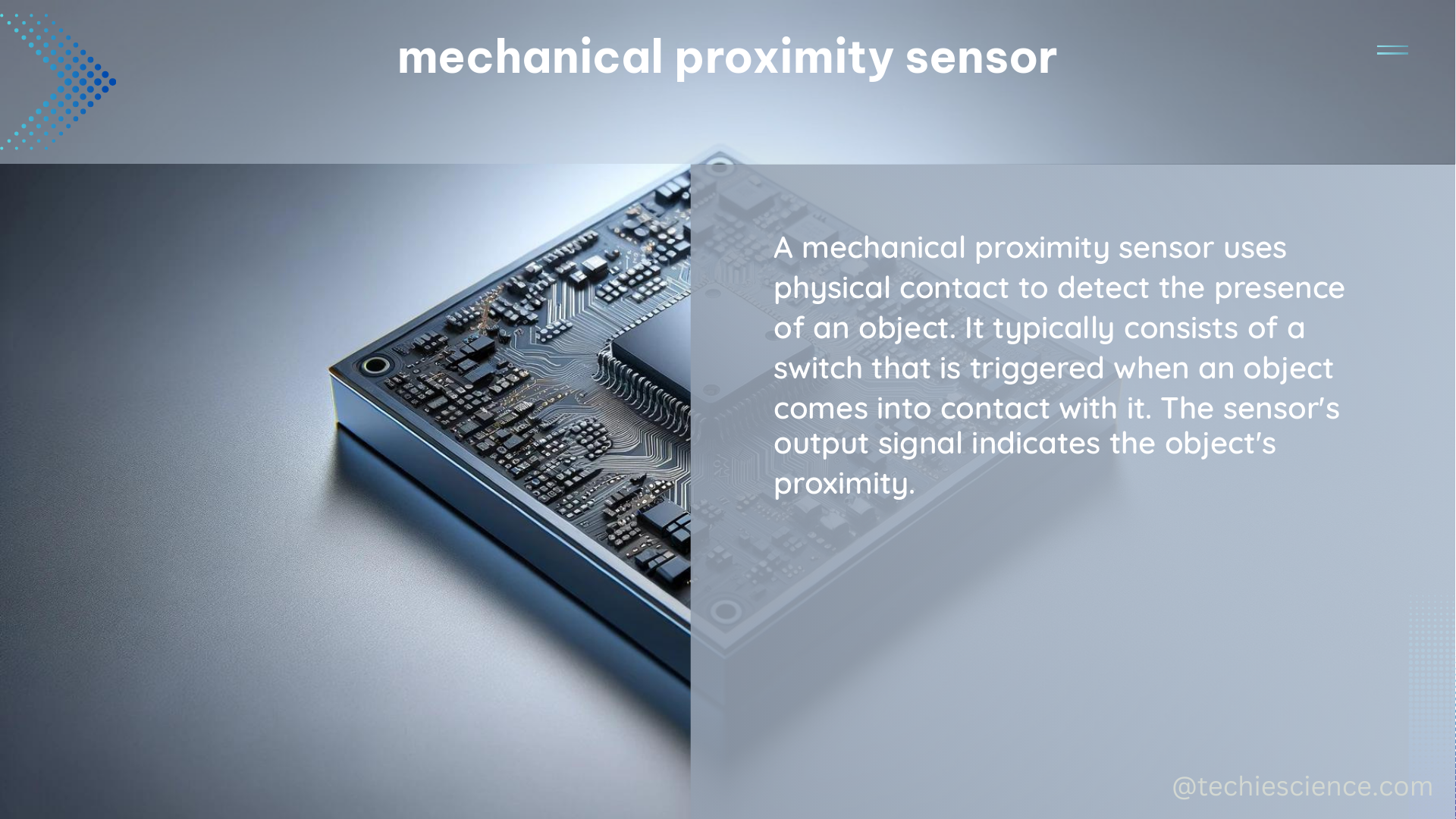Mechanical proximity sensors are non-contact devices that detect the presence or absence of an object without physical interaction. These sensors are widely used in various industries, including industrial automation, robotics, and consumer electronics, due to their reliability, durability, and versatility. In this comprehensive guide, we will delve into the intricacies of mechanical proximity sensors, covering their working principles, types, applications, and technical specifications.
Understanding the Fundamentals of Mechanical Proximity Sensors
Mechanical proximity sensors operate on the principle of detecting changes in physical parameters, such as magnetic fields or capacitance, to determine the presence or absence of an object. These sensors can be broadly classified into two main categories: inductive and capacitive.
Inductive Proximity Sensors
Inductive proximity sensors are widely used in the aviation industry due to their non-mechanical contact, safety, durability, reliability, and strong environmental suitability. They work by detecting changes in the magnetic field caused by the movement of a conductive object near the sensor. The detection range of these sensors typically ranges from 1 to 5 millimeters, with a measurement accuracy of 0.2 to 1.0 millimeters. Inductive proximity sensors are commonly used in various dynamic controls, such as landing gear, cabin doors, panels, and thrust reversers.
Technical Specifications of Inductive Proximity Sensors
- Detection Range: 1 to 5 millimeters
- Measurement Accuracy: 0.2 to 1.0 millimeters
- Operating Frequency: 50 to 500 kHz
- Power Supply: 10 to 30 VDC
- Output Signal: NPN, PNP, or analog
- Environmental Resistance: Resistant to dust, moisture, and harsh conditions
Capacitive Proximity Sensors
Capacitive proximity sensors, on the other hand, work by detecting changes in capacitance caused by the deformation or deflection of a component electrode under an applied mechanical stimulus. These sensors offer several advantages, including low power consumption, good dynamic response, and low susceptibility to temperature and humidity changes compared to piezoresistive sensors. Capacitive proximity sensors are known for their excellent proximity sensing ability in non-contact situations. However, they are vulnerable to electromagnetic noise, and the parasitic coupling with the surroundings needs to be carefully investigated and addressed.
Technical Specifications of Capacitive Proximity Sensors
- Sensing Range: 1 to 50 millimeters
- Measurement Accuracy: 0.1 to 1.0 millimeters
- Capacitance Range: 1 to 100 pF
- Power Supply: 5 to 24 VDC
- Output Signal: NPN, PNP, or analog
- Environmental Resistance: Resistant to dust, moisture, and some chemical agents
The capacitance of a capacitive proximity sensor is calculated using the formula: C = ε × A / d, where C is the capacitance, ε is the permittivity of the medium, A is the effective overlapping area, and d is the separation distance.
Applications of Mechanical Proximity Sensors

Mechanical proximity sensors find a wide range of applications across various industries, including:
- Industrial Automation: Monitoring and control of machinery, object detection, and position sensing.
- Robotics: Collision avoidance, object detection, and end-effector positioning.
- Consumer Electronics: Proximity-based controls in devices like smartphones, laptops, and keyboards.
- Automotive: Proximity-based controls in vehicles, such as door opening/closing, parking assistance, and collision avoidance.
- Aerospace: Dynamic controls in aircraft, such as landing gear, cabin doors, panels, and thrust reversers.
- Building Automation: Proximity-based controls for lighting, HVAC, and security systems.
Enhancing Mechanical Proximity Sensor Performance with Machine Learning
Recent advancements in machine learning (ML) have opened up new possibilities for enhancing the performance of mechanical proximity sensors. By incorporating ML techniques, these sensors can achieve improved accuracy, reliability, and adaptability to changing environmental conditions.
One example of ML-enhanced mechanical proximity sensors is the use of neural networks for object detection and classification. By training the sensor’s algorithms on a diverse dataset of objects, the sensor can accurately identify and differentiate between various targets, even in complex or cluttered environments.
Another application of ML in mechanical proximity sensors is adaptive threshold adjustment. By continuously monitoring the sensor’s performance and adjusting the detection thresholds based on environmental factors, the sensor can maintain optimal performance and minimize false positives or negatives.
Conclusion
Mechanical proximity sensors are essential components in a wide range of applications, from industrial automation to consumer electronics. By understanding the working principles, technical specifications, and applications of these sensors, engineers and technicians can make informed decisions when selecting and integrating them into their systems.
Moreover, the integration of machine learning techniques has the potential to further enhance the capabilities of mechanical proximity sensors, leading to improved accuracy, reliability, and adaptability. As technology continues to evolve, the role of mechanical proximity sensors in shaping the future of automation, robotics, and smart devices will only become more prominent.
References
- Sensor Systems – ScienceDirect
- Capacitive Proximity Sensor Based on Flexible Printed Circuit Board for Wearable Applications
- MX Keys proximity sensor malfunction
- Capacitive Proximity Sensor Based on Flexible Printed Circuit Board for Wearable Applications
- Capacitive Proximity Sensor Based on Flexible Printed Circuit Board for Wearable Applications

The lambdageeks.com Core SME Team is a group of experienced subject matter experts from diverse scientific and technical fields including Physics, Chemistry, Technology,Electronics & Electrical Engineering, Automotive, Mechanical Engineering. Our team collaborates to create high-quality, well-researched articles on a wide range of science and technology topics for the lambdageeks.com website.
All Our Senior SME are having more than 7 Years of experience in the respective fields . They are either Working Industry Professionals or assocaited With different Universities. Refer Our Authors Page to get to know About our Core SMEs.